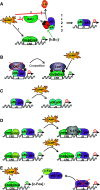Cyclic AMP: a selective modulator of NF-κB action
- PMID: 21744067
- PMCID: PMC11114830
- DOI: 10.1007/s00018-011-0757-8
Cyclic AMP: a selective modulator of NF-κB action
Abstract
It has been known for several decades that cyclic AMP (cAMP), a prototypical second messenger, transducing the action of a variety of G-protein-coupled receptor ligands, has potent immunosuppressive and anti-inflammatory actions. These actions have been attributed in part to the ability of cAMP-induced signals to interfere with the function of the proinflammatory transcription factor Nuclear Factor-kappaB (NF-κB). NF-κB plays a crucial role in switching on the gene expression of a plethora of inflammatory and immune mediators, and as such is one of the master regulators of the immune response and a key target for anti-inflammatory drug design. A number of fundamental molecular mechanisms, contributing to the overall inhibitory actions of cAMP on NF-κB function, are well established. Paradoxically, recent reports indicate that cAMP, via its main effector, the protein kinase A (PKA), also promotes NF-κB activity. Indeed, cAMP actions appear to be highly cell type- and context-dependent. Importantly, several novel players in the cAMP/NF-κB connection, which selectively direct cAMP action, have been recently identified. These findings not only open up exciting new research avenues but also reveal novel opportunities for the design of more selective, NF-κB-targeting, anti-inflammatory drugs.
Figures




Similar articles
-
Cyclic-AMP Increases Nuclear Actin Monomer Which Promotes Proteasomal Degradation of RelA/p65 Leading to Anti-Inflammatory Effects.Cells. 2022 Apr 21;11(9):1414. doi: 10.3390/cells11091414. Cells. 2022. PMID: 35563720 Free PMC article.
-
Thymulin and zinc (Zn2+)-mediated inhibition of endotoxin-induced production of proinflammatory cytokines and NF-kappaB nuclear translocation and activation in the alveolar epithelium: unraveling the molecular immunomodulatory, anti-inflammatory effect of thymulin/Zn2+ in vitro.Mol Immunol. 2009 Dec;47(2-3):205-14. doi: 10.1016/j.molimm.2009.09.034. Epub 2009 Oct 21. Mol Immunol. 2009. PMID: 19850345
-
NF-κB enhances hypoxia-driven T-cell immunosuppression via upregulation of adenosine A(2A) receptors.Cell Signal. 2014 May;26(5):1060-7. doi: 10.1016/j.cellsig.2014.01.024. Epub 2014 Jan 29. Cell Signal. 2014. PMID: 24486403
-
A most versatile kinase: The catalytic subunit of PKA in T-cell biology.Int Rev Cell Mol Biol. 2021;361:301-318. doi: 10.1016/bs.ircmb.2021.01.005. Epub 2021 Jan 27. Int Rev Cell Mol Biol. 2021. PMID: 34074497 Review.
-
Reinventing the wheel of cyclic AMP: novel mechanisms of cAMP signaling.Ann N Y Acad Sci. 2002 Jun;968:49-64. doi: 10.1111/j.1749-6632.2002.tb04326.x. Ann N Y Acad Sci. 2002. PMID: 12119267 Review.
Cited by
-
A Review of the Clinical Trial Landscape in Psoriasis: An Update for Clinicians.Dermatol Ther (Heidelb). 2022 Dec;12(12):2715-2730. doi: 10.1007/s13555-022-00840-9. Epub 2022 Nov 1. Dermatol Ther (Heidelb). 2022. PMID: 36319883 Free PMC article. Review.
-
Activation of cyclic adenosine monophosphate-dependent protein kinase a signaling prevents liver ischemia/reperfusion injury in mice.Liver Transpl. 2012 Jun;18(6):659-70. doi: 10.1002/lt.23399. Liver Transpl. 2012. PMID: 22290937 Free PMC article.
-
Recent Developments and Future Perspectives of Purine Derivatives as a Promising Scaffold in Drug Discovery.Curr Top Med Chem. 2024;24(6):541-579. doi: 10.2174/0115680266290152240110074034. Curr Top Med Chem. 2024. PMID: 38288806 Review.
-
Melanocortin 1 Receptor (MC1R): Pharmacological and Therapeutic Aspects.Int J Mol Sci. 2023 Jul 29;24(15):12152. doi: 10.3390/ijms241512152. Int J Mol Sci. 2023. PMID: 37569558 Free PMC article. Review.
-
Isoforskolin Alleviates AECOPD by Improving Pulmonary Function and Attenuating Inflammation Which Involves Downregulation of Th17/IL-17A and NF-κB/NLRP3.Front Pharmacol. 2021 Jul 30;12:721273. doi: 10.3389/fphar.2021.721273. eCollection 2021. Front Pharmacol. 2021. PMID: 34393799 Free PMC article.
References
Publication types
MeSH terms
Substances
LinkOut - more resources
Full Text Sources
Other Literature Sources

